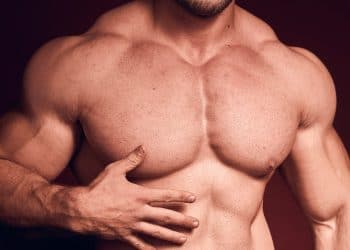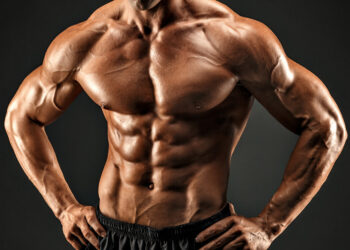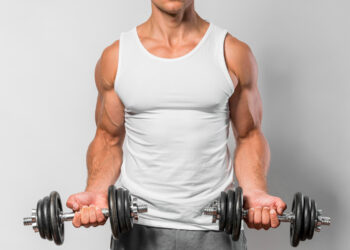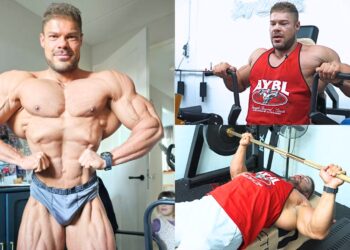Chest training – we all love it! There is nothing quite as satisfying as pumping out some heavy reps of barbell or dumbbell bench presses and feeling satisfied with a job well done. However, a lot of guys are guilty of following the same chest-building workout for weeks, months, or even years at a time. This is a big mistake.
To grow, your body needs a variety of exercises. In fact, studies tell us that exercise variety is just as important as load assignment and reps ranges for muscle growth. This is especially true for the chest muscles, properly called pectoralis major, or pecs for short. [1]
Take your pec development to a whole new level with the best chest exercises.
Chest Anatomy
The pectoralis major is a large, thick, fan-shaped muscle located on the upper part of your chest. Its name comes from the word pectus, which is the Latin word for breast. This muscle makes up the bulk of your chest mass. The underlying muscle, pectoralis minor, is much thinner and doesn’t contribute much to the size of your chest. Subsequently, the focus of this article is the pec major.
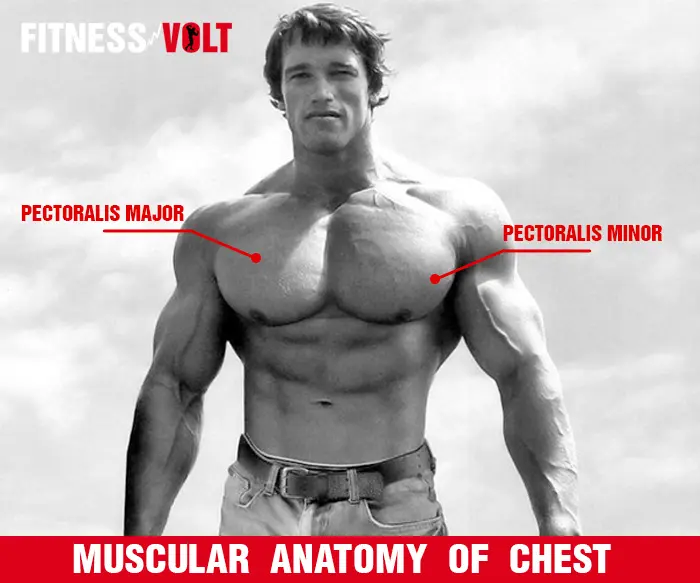
The pectoralis major is a convergent muscle with three broad attachment sites that come together at a single insertion point. It can be divided into two sections or heads – the clavicular or upper head, and the sternal or lower head. The sternal head is also known as the abdominal head. [2]
The functions of the pectoralis major are…
Level Up Your Fitness: Join our 💪 strong community in Fitness Volt Newsletter. Get daily inspiration, expert-backed workouts, nutrition tips, the latest in strength sports, and the support you need to reach your goals. Subscribe for free!
The Clavicular head:
- Shoulder flexion
- Horizontal adduction
- Internal rotation
The Sternal head:
- Shoulder extension
- Horizontal adduction
- Internal rotation
The clavicular head of the pectoralis major, often just called the upper pecs, is more active during incline chest exercises. Conversely, the sternal head, or lower pecs, is more active during decline movements. Because of this, you must train your pecs from multiple angles to develop it fully.
Do you need to be an expert in pec anatomy to build a chest to be proud of? Probably not! But it is useful to understand these basics so you can choose the best exercise for sculpting the chest of your dreams. To help you on your way, here are the ten best chest-building exercises.
The Best Chest Exercises
To get the most from these chest exercises, make sure you use the right weight and set and rep scheme. While it’s okay to train outside of these parameters occasionally, the bulk of your workouts should match your goal.
- For strength, do sets of 1-5 reps using heavy weights, resting 3-5 minutes between sets.
- For hypertrophy, do sets of 6-12 reps with moderate weights, resting 60-90 seconds between sets.
- For endurance, do sets of 13-20 reps with light weights, resting 30-60 seconds between sets.
Also, remember to warm up before you start working out. A few minutes of light cardio plus some dynamic stretches will help, and you should also do a couple of light sets of your main exercises to fully prepare your joints and muscles for what you are about to do.
Best Dumbbell Chest Exercises
- Dumbbell Bench Press
- Incline Dumbbell Press
- Dumbbell Chest Fly
- Dumbbell Squeeze Press
- Dumbbell Floor Press
1. Dumbbell Bench Press
Muscles targeted: Chest, shoulders, triceps, and core.
As popular as the barbell bench press is, for some bodybuilders, it may not be the best choice. For example, if you have short arms or a very deep barrel chest, your range of motion will be shorter than if you have long arms because the bar will touch your chest sooner.
While this may be helpful for lifting heavy weights, it also means the bench press is not always the best chest builder for short-armed guys. Others find that using a barbell is hard on their shoulders. The good news is that dumbbell bench presses are an ideal alternative.
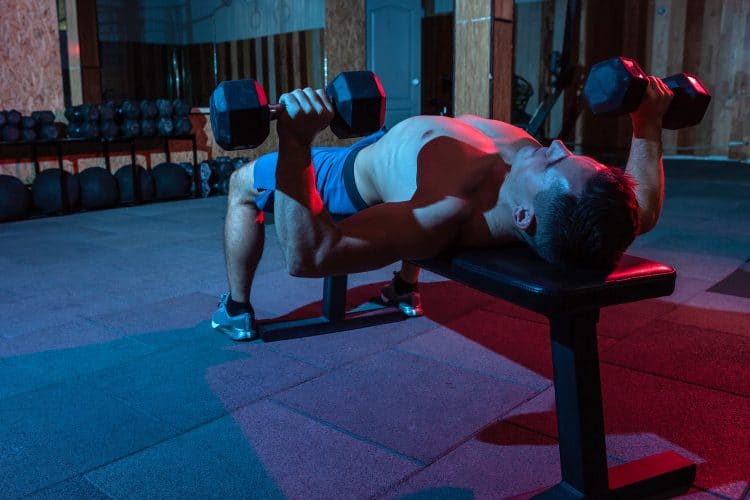
How to do it:
- Lie on an exercise bench with a dumbbell in each hand, pressed up to arm’s length. Your palms should be facing down your body.
- Bend your arms and lower the weights down to just outside your shoulders.
- Press your dumbbells back up and repeat.
Benefits:
- No need for a spotter; just lower the weights to the floor if you are unable to complete a rep.
- Useful for fixing left-to-right strength imbalances.
- Easier on the shoulder joints than barbell bench presses.
- A larger range of motion than barbell bench presses.
2. Incline Dumbbell Press
Muscles targeted: Upper chest, shoulders, triceps, and core.
Incline dumbbell press is designed to emphasize more on the upper portion of the chest. This exercise requires you to set the bench at 30-45 degrees. It is a compound movement that will support the development of strength and hypertrophy of the upper chest, shoulders, and triceps.
How to do it:
- Grab a pair of dumbbells with both hands using a neutral grip.
- Sit on the edge of the incline bench and rest the dumbbells on your legs.
- Brace your core and retract your shoulder blades.
- Lean back and press both dumbbells over your chest.
- Now inhale and bend your elbows to slowly bring the weight down until the dumbbells reach your chest height.
- Exhale and push the dumbbells back up.
- Repeat for the recommended number of reps.
Benefits:
- Add size and strength to your upper chest.
- Incline dumbbell press also strengthens the shoulders and triceps.
- Training with dumbbells allows you to equally train both sides.
3. Dumbbell Chest Fly
Muscles targeted: Chest and shoulders.
Dumbbell fly is an isolation exercise. This means they involve movement at only one joint. Unlike compound chest exercises, which also involve your triceps, dumbbell flyes are a much purer chest exercise. You won’t be able to lift as much weight but, with minimal triceps involvement, it’ll still feel challenging. Take care not to lower the weights too far as this could lead to a shoulder injury.
How to do it:
- Lie on a bench with a dumbbell in each hand. Press the weights up to arm’s length. Rotate your wrists so that your hands are facing inward. Bend your elbows slightly, but then keep them rigid.
- Open your arms and lower the dumbbells down and out to your sides. Your arms should be perpendicular to your body. Get a good stretch, but do not hyperextend your shoulders.
- Use your pecs to squeeze the weights back up and repeat.
Benefits:
- Can be done on a flat, incline, or decline bench to target different parts of the chest.
- Improves strength of chest adduction.
- A good finishing exercise.
- Good for pec flexibility and shoulder mobility.
4. Dumbbell Squeeze Press
Muscles targeted: Chest, triceps, and shoulders.
This exercise keeps your pecs under almost constant tension. This is in contrast to nearly every other chest exercise where, because of leverage, your pecs get a brief rest between reps. You don’t need a lot of weight for this exercise, making it easy on your joints and also ideal for home exercisers who don’t have access to big dumbbells.
How to do it:
- Lie on your back with a dumbbell in each hand. Hex dumbbells work best for this exercise. Press the dumbbells together and keep pressing for the duration of your set.
- Bend your arms and lower the weights to your chest. Push them back up and repeat.
- You can do this exercise on a flat, incline, or decline bench to target different parts of your chest.
Benefits:
- Easy on your joints.
- Great for getting a chest pump.
- Does not require heavy weights.
5. Dumbbell Floor Press
Muscles targeted: Chest, shoulders, triceps, and core.
Do you experience pain in the shoulder when you do full-range bench presses? Then dumbbell floor press is a solution for you. Doing the chest press on the floor restricts the range of motion, which can relieve shoulder pain.
The floor press is an excellent variation for lifters at all fitness levels, it is a great exercise to develop muscle mass and lockout strength.
How to do it:
- Lie down on the floor with your chest facing up. Bend your knees and place your feet flat on the floor.
- Grab a pair of moderate-weight dumbbells with an overhead grip.
- Now extend your elbows to push the dumbbells towards the ceiling. This is the starting position!
- Inhale and bend your elbows to slowly bring the weight down. Let the back side of the arms lightly touch the ground.
- Exhale as you push the weight back up.
- Repeat for the recommended reps.
Benefits:
- Dumbbell floor press will build strength and size without stressing out the shoulders.
- Great variation when the bench is not available.
- It’s a beginner-friendly variation that also trains the lifters to keep the core tight while exercising.
Best Chest Exercises with Barbell
- Bench Press
- Incline Bench Press
- Close Grip Barbell Press
- Reverse Grip Barbell Press
- Decline Bench Press
- Guillotine Press
1. Bench Press
Muscles targeted: Chest, shoulders, triceps, and core.
The barbell bench press is probably the most popular chest exercise around. As well as being used by bodybuilders, the bench press is also the second discipline contested in powerlifting competitions. Whether you want to build powerful-looking pecs or unstoppable upper-body strength, the bench press can help.
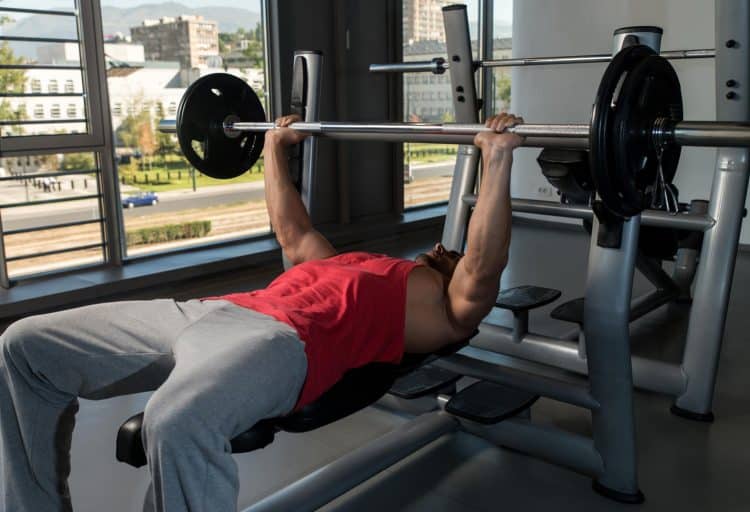
How to do it:
- Lie on your back on the bench press station. Your eyes should be directly beneath the bar. Reach up and hold it with an overhand, slightly wider than shoulder-width grip.
- Press your upper back into the bench, arch your lower back slightly, lift your chest up toward the ceiling, and push your feet firmly into the floor. Squeeze your shoulders down and back.
- Unrack the bar and hold it over your chest.
- Bend your arms and lower the bar to your sternum. Do not bounce the bar off your chest. Tuck your elbows slightly into your sides as the bar descends. Your forearms should be perpendicular to the floor at the bottom of each rep. If they are not, adjust your grip on your next set.
- Drive the bar back up to arms’ length and repeat.
Benefits:
- A good measure of upper-body strength
- A very popular, widely performed exercise
- Suitable for developing both strength and muscle size
2. Incline Bench Press
Muscles targeted: Upper chest, shoulders, triceps, and core.
Adopting an incline position increases clavicular or upper pec activation. Studies show that the best angle for targeting the upper pecs is 44 degrees. Most benches don’t allow for such precise adjustment, so shoot for 30-45 degrees. If you increase the angle beyond this, you’ll just end up working your deltoids (shoulders) more than your pecs. You can do incline bench presses using a barbell or dumbbells. [3]
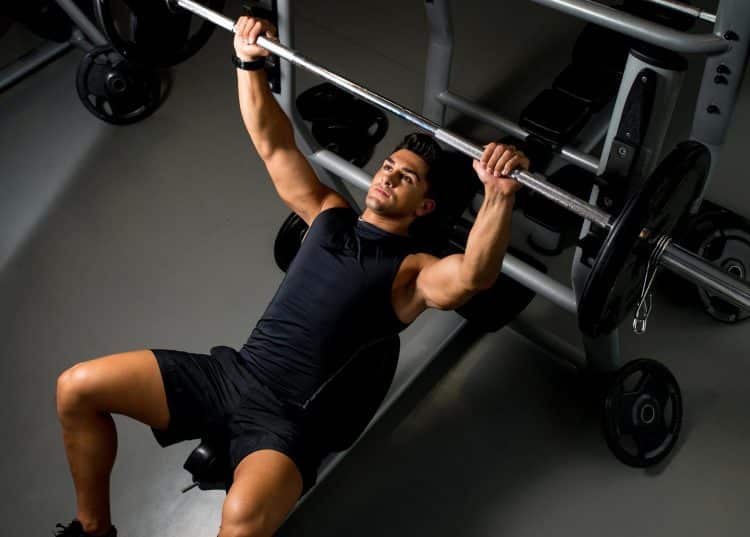
How to do it:
- Lie on an incline bench set to around 30-45 degrees. Hold the bar with a slightly wider than shoulder-width grip. Lift your chest and pull your shoulders down and back. Plant your feet firmly on the floor and arch your lower back slightly.
- Unrack the bar, bend your arms and lower the bar down to your upper chest.
- Press the weight back up and repeat.
Benefits:
- Allows you to emphasize your upper pecs.
- An effective muscle builder.
- Can also be done using dumbbells.
3. Close Grip Barbell Press
Muscles targeted: Inner chest, triceps, and shoulders.
Setting up a close grip barbell press is very much similar to a conventional bench press, but you grip the barbell differently. Instead of grabbing the barbell slightly wider than the shoulder’s width, you need to have a narrower grip (depending on your wrist comfort).
Close grip barbell press emphasizes more on the development of the inner chest and triceps. Keep your elbows close to the torso as you perform close grip barbell press.
How to do it:
- Lie on your back on the bench press station. Your eyes should be directly beneath the bar. Reach up and hold it with an overhand, closer than shoulder-width.
- Press your upper back into the bench, arch your lower back slightly, lift your chest up toward the ceiling, and push your feet firmly into the floor. Squeeze your shoulders down and back.
- Unrack the bar and hold it over your chest.
- Bend your arms and lower the bar to your sternum. Do not bounce the bar off your chest. Tuck your elbows slightly into your sides as the bar descends.
- Push the bar back up to fully extend your arms.
- Repeat for the recommended reps.
Benefits:
- Close grip barbell press allows you to develop stronger and bigger triceps.
- It also emphasizes more on inner chest development, plus it strengthens the bench press lockout.
- Keeping the elbows close to the torso reduces the stress on shoulder joints.
4. Reverse Grip Barbell Press
Muscles targeted: Upper chest, triceps, biceps, and shoulders.
Let’s talk about the “not so popular” version of the bench press that can add serious strength to your chest and triceps. It’s a variation where you use a supinated grip.
The reverse grip barbell press is an excellent exercise to target your upper chest and triceps. One of the major benefits of reverse grip is it relieves pressure off the shoulders.
How to do it:
- Lie down on a flat bench and grab the barbell with an underhand grip.
- Grip the barbell at shoulder width or slightly wider.
- Unrack the barbell and lower the bar until it touches your lower chest.
- Push the barbell straight up to return to the starting position.
- Keep your elbows tucked in throughout the movement.
Benefits:
- It’s an excellent exercise to strengthen the upper chest and triceps.
- Relieves pressure from the shoulders.
- You can do it with a set of dumbbells too.
5. Decline Bench Press
Muscles targeted: Lower chest and triceps.
The sternal or lower pecs are involved in all chest exercises, but using a decline bench allows you to preferentially emphasize this part of your chest. A lot of lifters also find that decline bench presses are easier on their shoulders than the flat and incline versions. If you can’t bench press because of shoulder pain, this exercise could be a good alternative. The ideal angle for targeting your lower pecs is around 15 degrees below parallel.
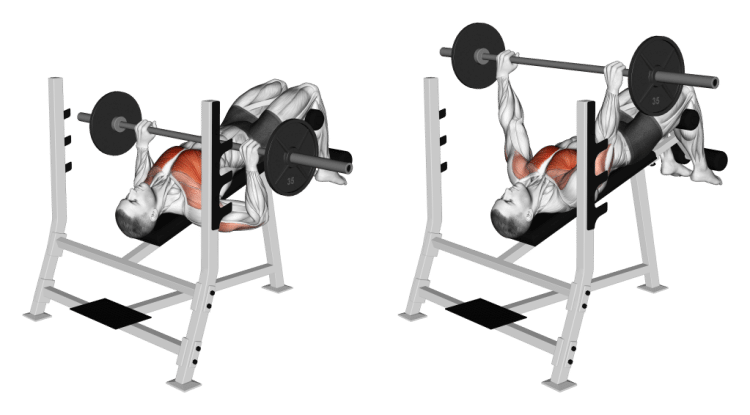
How to do it:
- Lie on your exercise bench with your head lower than your hips. If your bench has one, anchor your legs behind the pad. This will stop you from sliding down the bench.
- Hold the bar with a slightly wider than shoulder-width grip. Lift your chest and pull your shoulders down and back.
- Unrack the bar, bend your arms and lower it down to your sternum. Press the weight again up and repeat.
Benefits:
- Preferentially targets your lower chest.
- Less strain on the shoulder joint.
- Can also be done with dumbbells.
6. Guillotine Press
Muscles targeted: Upper chest, shoulders, and triceps.
The exercise is also known as the “neck press”, it is a very effective exercise for the upper chest as it provides an intense stretch in the clavicular pec head while limiting triceps engagement.
The guillotine press is performed with a barbell and includes lowering the bar to the neck. Remember to warm up your shoulders, as the extreme elbow flare can put high stress on the anterior delts.
How to do it:
- Setting up the guillotine press is the same as the straight bench press.
- Hold the bar slightly wider than shoulder-width apart. Flare your elbows wide.
- Lower the bar towards your neck until your elbows reach a 90-degree angle.
- Push the barbell up to the starting position.
- Complete a few reps before you rack the barbell.
Benefits:
- No need to use an incline bench to target the upper chest.
- May increase shoulder mobility and chest flexibility.
- This exercise results in extreme pec contraction.
Best Cable Chest Exercises
1. Cable Crossover
Muscles targeted: Chest and shoulders.
Cable crossover is an excellent exercise to develop strength and muscle hypertrophy. Allow your hands to go past the center of your chest to get better chest contraction.
How to do it:
- Attach two D-shaped handles to the top pulleys on a cable crossover machine. Hold one handle in each hand and stand in the middle of the weight stacks, arms outstretched and about shoulder height. Brace your abs and adopt a split stance for balance. Lean forward slightly from your hips. Your elbows should be a little bent but rigid.
- Without bending your elbows further, draw your arms forward and down, so they meet in front of your hips.
- Return to the starting position and repeat for the allotted number of reps.
- On completion, immediately move to the next exercise.
Benefits:
- Cable crossover is an exercise that improves chest definition.
- It’s a beginner-friendly exercise that develops the chest midline.
- It also strengthens chest adduction.
2. Incline Cable Bench Press
Muscles targeted: Chest, triceps, and shoulders.
Incline cable bench press is a great chest exercise that improves muscle strength while working on strength imbalances.
One of the best things about the cable bench press is the constant force that the muscle fibers experience. Even in the lockout position, you will experience great resistance.
How to do it:
- Set your bench at about 30-45 degree incline and the pulleys at the lowest setting.
- Grab the handles and lie down on the bench.
- Plant your feet on the ground and lift your chest up while keeping a slight arch in the back.
- Retract the shoulder blades and keep your elbows slightly bent.
- Exhale and contract your chest to bring both hands together.
- Inhale while slowly returning to the starting position.
Benefits:
- It improves upper chest hypertrophy and strength.
- Experience superior muscle pump.
- Incline cable bench press keeps the chest under constant tension.
- Great exercise for those who have strength imbalance.
3. Cable Hex Press
Muscles targeted: Chest and shoulders.
Cable hex press is a chest isolation exercise that will help you develop a chiseled chest with a well-defined midline.
How to do it:
- Set the pulley at your chest level.
- Stand in the middle of a cable machine with your feet at shoulder-width distance.
- Grab handles with both hands in a neutral position and keep your elbows close to the torso. Bring both hands close to the chest, and this is your starting position.
- Retract your shoulder blades, and lift the chest up. You should already experience decent tension within the inner pecs as the handles will be trying to pull your hands away.
- Now, just push the handles forward while keeping the hands close. Hold the contraction for a second before you bring your hands to starting position.
- Repeat for the recommended number of reps.
Benefits:
- Great variation to experience chest pump.
- It keeps constant tension on the inner chest.
- Develops well-defined chest midline.
4. Single Arm Cross Body Fly
Muscles targeted: Chest.
Unilateral exercises are great for improving the mind-muscle connection and correcting the strength imbalance. Single arm cross body fly is a chest isolation movement that allows you to work on a single chest at a time.
How to do it:
- Set the pulley at the middle position, around the height of your chest.
- Grab the handle with one hand and step away from the cable machine to get your arm fully extended and parallel to the floor.
- Maintain a slight bend in the elbows and keep your torso tight.
- Sweep your arms in front of you like you are about to give a big hug to someone.
- Bring the arm slowly to the starting position and repeat for the recommended number of reps.
Benefits:
- This movement allows you to equally train both sides.
- It enhances core stability by developing anti-rotational force.
Find out more Cable Chest Exercises to develop serious pec power!
Best Chest Machine Exercises
1. Pec Deck
Muscles targeted: Chest.
The pec deck is a popular gym exercise. It allows you to work your pecs without having to worry about balancing a barbell or dumbbells. Because of this, it’s a good exercise if you want to train to failure. It’s also an excellent choice for things like drop sets and forced reps.
Please note: some pec deck machines have arm pads while others have handles. Both machines are similarly effective.
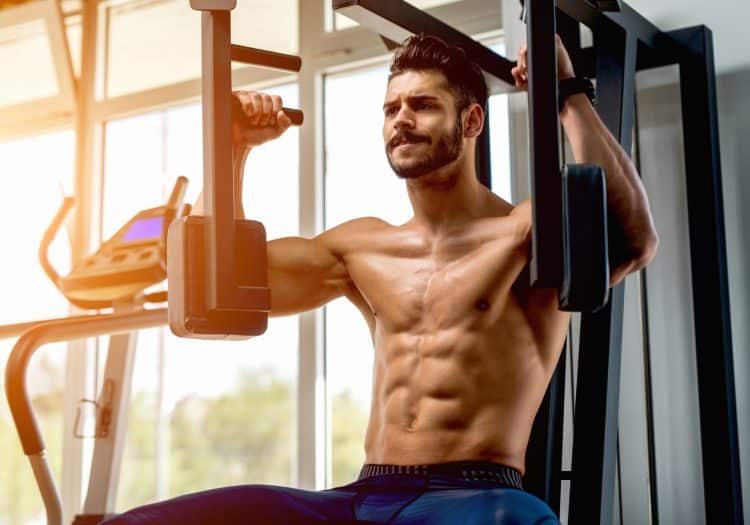
How to do it:
- Adjust the seat so that, when you hold the handles, your arms are perpendicular to the floor. Grab the handles and bend your arms slightly. Keep them rigid for the duration of your set. Pull buyout shoulders down and back and keep them pressed against the back support. Be careful not to overextend your shoulders, adjusting your starting position to accommodate your shoulder mobility and chest flexibility.
- Push your arms forward and together.
- Slowly open your arms to lower the weight and repeat.
Benefits:
Level Up Your Fitness: Join our 💪 strong community in Fitness Volt Newsletter. Get daily inspiration, expert-backed workouts, nutrition tips, the latest in strength sports, and the support you need to reach your goals. Subscribe for free!
- An easy exercise to master.
- Allows you to isolate your chest.
- Removes your triceps from the exercise.
- Good for hypertrophy and endurance.
2. Chest Press Machine
Muscles targeted: Chest, triceps and shoulders.
Working your pecs on a chest press machine leaves you free to focus on cranking out as many reps as possible. You don’t have to worry about balancing the weights or whether you’ll complete your next rep; you can train to failure in safety. Use a chest press machine to wring the last drop of energy out of your pecs.
Please note: chest press machine designs vary. Make sure you use the model at your gym according to the manufacturer’s instructions.
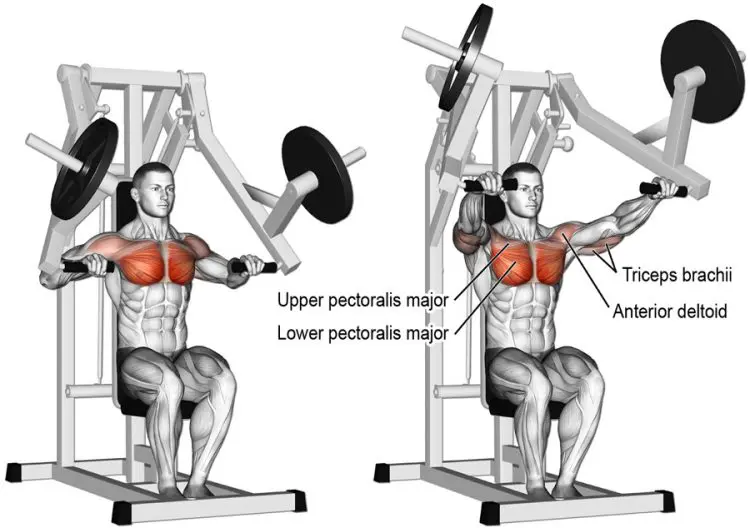
How to do it:
- Adjust the seat so that the handles are level with your armpits. Grab the handles with an overhand grip, lift your chest, and slightly arch your lower back.
- Extend your arms and push the handles away from you. Stop just short of locking your elbows.
- Lower the weights and repeat.
Benefits:
- Easy to learn.
- Train to failure safely.
- Most chest press machines offer several hand positions for variety and comfort.
Best Bodyweight Chest Exercises
1. Push-ups
Muscles targeted: Chest, shoulders, triceps, and core.
Push-ups are probably the most widely performed exercise in the world! From elite athletes to kids at school, almost everyone has done at least a few push-ups. This bodyweight exercise is a very useful chest exercise because you can do it anywhere and anytime. With your feet on the floor, push-ups are a decline chest exercise. But, the more you elevate your feet, the more they affect your upper chest. Change the angle of your body according to the part of your chest you want to emphasize.

How to do it:
- Kneel down and place your hands on the floor, slightly wider than shoulder-width apart. Your fingers should be pointing forward. Rotate your hands outward to stabilize your shoulders and maximize chest muscle activation.
- Bend your arms and lower your chest to within an inch of the floor. Do not allow your hips to sag.
- Extend your arms and repeat, remembering to keep your body straight throughout.
- Elevate your feet to put more weight on your hands and increase upper pec activation. Bend your legs and rest on your knees to make this exercise easier.
Benefits:
- You can do push-ups anywhere and any time.
- Easy to modify for a harder or easier workout.
- Easy on your joints.
2. Diamond Push-ups
Muscles targeted: Chest, triceps, shoulders, and core.
Diamond push-up is a close grip variation that allows you to emphasize the tricep and mid-line of the chest.

How to do it:
- Kneel down and place your hands flat on the floor so that your thumb and first finger form a diamond shape, which is where this exercise gets its name.
- Supporting your weight on your hands, walk your feet back, so your body is straight. Brace your abs.
- Bend your arms and lower your chest to lightly touch the back of your hands. Push yourself back up and repeat, continuing until you can no longer do any more reps.
- Rest a moment and then go back to the previous exercise.
Benefits:
- Increase the tricep strength and size.
- Diamond push-up improves core strength and stability because of the narrow base created by close hand positioning.
- This exercise also improves shoulder strength because of the longer range of motion.
3. Pike Push-ups
Muscles targeted: Shoulders, upper chest, triceps, and core.
Pike push-up is a great upper-body strength builder that strengthens shoulders, upper chest, and triceps.
Pike push-ups are not the best for beginners as it requires extensive shoulder strength and stability. If you are trying this move for the first time, then you should pay a lot of emphasis on slow and controlled reps. To increase the difficulty of the pike push-up, elevate your feet up onto an object such as a box, chair, bench, etc.

How to do it:
- Get into the push-up position, and lift your hips up and back until you get into an inverted V position.
- Your feet and hands should be about three feet apart.
- Place your hands shoulder-width apart. Arms should be straight and elbows back.
- Bend your elbows to bring the body down to the floor.
- Hold for a second and then push back to get into starting position.
- Repeat for as many reps as possible.
Benefits:
- Pike push-ups strengthen the upper chest and improve your bench press by strengthening your shoulders.
- Anyone looking to perform their first handstand should start with pike push-ups and gradually progress to handstands.
4. Archer Push-Ups
Muscles targeted: Chest, triceps, and shoulders.
Archer push-ups are the advanced version of regular push-ups that improves unilateral pressing strength. While doing archer push-ups, one hand does the pushing work, and the other provides balance and support to the movement.
How to do it:
- Get into a push-up position with your arms a little wider than shoulder width.
- Maintain a strong core and keep your body in a straight line.
- Now bring your body down to the left side while straightening the other hand to assist the left hand.
- Push yourself up as you reach the bottom.
- Now follow the same on the other side. Alternate between both sides.
Benefits:
- It improves upper-body strength and hypertrophy.
- It allows you to prepare for single-hand push-ups.
- Archer push-up corrects the strength imbalances.
- Enhance the core strength by providing stability and full body control.
5. Dips
Muscles targeted: Lower chest, triceps, and shoulders.
While barbells, dumbbells, and even machines may be your first choice for building a bigger chest, you can achieve impressive results with bodyweight exercises too. Parallel dips are a challenging exercise that emphasizes your lower pecs. Be warned, this exercise can also be hard on your shoulders, especially if you descend too far or bounce out of the bottom of your reps.
How to do it:
- Grab the parallel handles and step or jump up so your arms are supporting all your weight. Lift your chest and lean forward slightly. Cross your feet behind you to help with this.
- Bend your arms and descend until your upper arms are at least parallel to the floor.
- Push back up and repeat.
- A wider-than shoulder-width grip increases chest activation but also increases shoulder joint stress.
Benefits:
- Dips are also an effective triceps builder.
- Dips improve the bench press by improving pressing performance.
- Can be made harder by using a weighted dipping belt.
- Useful for targeting the lower pecs.
6. Spiderman Push-Up
Muscles targeted: Chest, triceps, shoulders, abs, obliques, hip flexors, and quadriceps.
This is an intense core stability exercise that will challenge the entire upper body. This push-up variation won’t really turn you into a Spiderman, but it will surely help you develop superhero-level chest and core strength.
It’s a great compound movement that will improve strength, stability, and coordination.
How to do it:
- Start with a high plank position with your hands slightly wider than the shoulder’s width.
- Bend your arms and lower your chest to within an inch of the floor. As you do this, laterally flex at your hip, bringing your knee towards your triceps.
- As you push yourself up, bring your leg back to the starting position.
- Keep alternating the legs with every repetition.
Benefits:
- It’s a functional exercise that enhances upper-body strength, core control, and full-body coordination.
- Develop anti-rotational core strength with Spiderman push-ups.
Related: Find More Cable Chest Exercises to Develop Serious Pec Power
4 Chest Training Routines
Training routines are not built on the “one size fits all” concept. That’s the reason we designed four chest training routines that can you choose according to your fitness goals.
#1 Chest Training Routine While Bulking
Gaining maximum strength and muscle mass is the ultimate goal of bulking phase, and we have designed a training routine keeping that in mind.
While in the bulking phase, one should ensure that you are in a caloric surplus.
| Exercise | Reps | Sets | Rest Period | |
| 1. | Incline bench press | 8-10 | 4 | 90 secs |
| 2. | Dumbbell bench press | 8-10 | 4 | 90 secs |
| 3. | Close grip chest press | 8-10 | 4 | 90 secs |
| 4. | Dumbbell chest fly | 10-12 | 3 | 60 secs |
| 5. | Dumbbell squeeze press | 8-12 | 3 | 60 secs |
| 6. | Dips | AMRAP | 4 | 90 secs |
#2 Chest Training Routine While Cutting Phase
While in the cutting phase, your main focus should be achieving muscle definition and lowering the fat percentage. One should not train with high volume as you are in a caloric deficit.
In this training program, we kept the rep range high and the rest period short to assist you obtain improved muscle definition.
| Exercise | Reps | Sets | Rest Period | |
| 1. | Dumbbell bench press | 10-12 | 4 | 90 secs |
| 2. | Reverse grip bench press | 10-12 | 4 | 60 secs |
| 3. | Close grip hex press | 10-15 | 3 | 60 secs |
| 4. | Cable cross over | 10-15 | 3 | 60 secs |
| 5. | Single arm cross body fly | 10-12 | 3 | 60 secs |
#3 Chest Training Routine For Beginners
Even if your goal is to trim down excess weight, your first goal should be to gain enough strength. Packing on some muscle mass will boost your metabolic rate, which will help you with cutting down extra weight.
As a beginner, your main goal should be to get stronger. Make sure you are eating protein-rich meals to improve muscle recovery.
This training program contains all the beginner-friendly exercises that will create a stronger foundation.
| Exercise | Reps | Sets | Rest Period | |
| 1. | Push-ups | AMRAP | 4 | 90 secs |
| 2. | Chest press machine | 8-10 | 4 | 90 secs |
| 3. | Dumbbell bench press | 8-10 | 4 | 90 secs |
| 4. | Pec deck | 10-12 | 4 | 90 secs |
| 5. | Dumbbell chest fly | 8-12 | 3 | 60 secs |
#4 Bodyweight-only Chest Program
Not having bodybuilding equipment should not be an excuse. One can gain decent strength and size with the bodyweight-only training program too.
| Exercise | Sets | Rest Period | |
| 1. | Dips | 4 | 90 secs |
| 2. | Push-ups | 4 | 90 secs |
| 3. | Incline Push-ups | 4 | 90 secs |
| 4. | Pike Push-ups | 3 | 90 secs |
Number of reps should depend on the individual’s fitness level. As you progress towards a stronger version of yourself, you can add resistance by wearing a weighted vest.
What Are The Best Ways To Warm Up Your Chest?
Are you paying enough emphasis on proper warmup before you hit those heavy bench presses? With the warmup, we don’t mean static stretching of the target muscle fiber, nor do we mean 15 minutes of jogging on a treadmill.
A dynamic warmup is an ultimate way to prepare your muscle fibers for the heavy load. Dynamic warmup not only gets the blood flowing into the muscle but also prepares your nervous system for the lifting. Let’s have a look at the best chest warm up exercises.
Dips
Two sets of bodyweight dips is a wonderful exercise to warm up your chest, tricep, and shoulders. It activates the muscle fibers with a pushing mechanism to help you go heavy while bench presses.
Dips also improve shoulder mobility and enhance lockout strength which significantly improves pressing ability.
Plyo Pushups
Plyo pushups are an advanced variation that adds a “jumping” element to regular pushups. These pushups add explosive energy to the chest, triceps, shoulders, and core.
Plyo pushups activate the fast-twitch muscle fibers. Fast-twitch muscle fibers are built for short, powerful bursts of energy. Activating these muscle fibers will improve your ability to bring force and agility to the movement. Additionally, fast twitch muscle fibers are larger in size, which means activating these fibers will help with the size gains too.
Can’t do plyo push-ups? No worries, you can do kneeling plyo push-ups.
Band Pull-apart
Scapula retraction plays an important role in keeping the shoulders stable and strong while training the chest. Band pull-apart activates and strengthens the muscle around the scapula and upper back, thus helping in preventing injuries.
How to do it: Grab a resistance band with an overhand or underhand grip while keeping the arms fully extended and parallel to the ground. Extend body arms to the sides while maintaining full control.
What Foods to Eat to Get a Big Chest?
Without proper nutrition, it’s hard to maximize muscle gains! You can not do justice to the workout program if you are not paying enough emphasis to nutrition. In this part, we are going to cover the nutritional aspect of building a bigger and stronger chest.
Know Your Maintenance Calories
Whether you want to gain muscle size or lose stored fat, knowing your body’s daily calorie requirement is the basic information that every fitness enthusiast should know.
Once you know the daily calorie requirements, then you can increase or decrease the calorie intake as per the desired goal. If you want to gain size, eat more calories than your body requires to optimize muscle recovery. You can use calorie tracker apps to count your daily calorie intake.
Understand The Macro Requirements
Protein, carbohydrates and fats are the three macronutrients that you need to take care of. Let’s understand all three macronutrients in detail.
Protein
You may agree or disagree with the health benefits of carbs or fats, but everyone certainly agrees with the fact that protein consumption is important.
Protein is the most important macronutrient that you should emphasize when you are trying to gain muscle size. A 2012 study has confirmed that increasing protein intake increases muscle mass and strength. Additionally, a high proteins diet is also proven to have weight loss benefits. [4] [5]
How much protein do you need in every meal?
If you are having five meals a day, then you can split your protein into five equal parts. It is suggested to increase the amount of protein in a post-workout meal.
A recent 2018 paper was published about “Recent perspectives regarding the role of dietary protein for the promotion of muscle hypertrophy with resistance exercise training”. [6]
Researchers stated:
- Daily protein intake of 1.6 g/kg body mass per day to maximize protein synthesis.
- Every meal should contain at least 20 grams of protein to maximize muscle protein synthesis.
- Protein meals should be separated by at least three hours to maximize muscle protein synthesis.
What is the best source of protein?
Animal-based foods, including meat, poultry, fish, eggs, and dairy, are the optimum source of protein as they provide the complete amino acid profile. Plant-based foods such as fruits, vegetables, grains, nuts, and seeds often lack one or more essential amino acids.
If you find it difficult to consume a sufficient amount of protein, then supplementing with whey protein is always a good idea.
Carbohydrates
Do not neglect the importance of carbohydrates. Carbohydrates support rapid recovery and provide energy to fuel your intense workout sessions. You may feel drained and sluggish while workout if you are not eating enough carbs.
Carbs also play a very important role in muscle size. Muscle has its glycogen reserves, every gram of glycogen stores three to four grams of water. That means the more glycogen your muscle holds, the more fuller they look.
Fats
Fifteen percent of the total daily calories should come from healthy fats. Fats improve cognitive functioning and regulate many hormones that are critical for muscle building, including testosterone. Fat also helps the body absorb vitamins A, D, and E.
Eat Clean
In order to stay in a calorie surplus, you should not be consuming junk calories. Highly processed food or food items that are high in sugar will eventually lead to gaining more fat, not muscle.
Frequently Asked Questions
Do you have any questions? We’ve got the answers! If you can’t find the answer you’re looking for below, drop us a line in the comments section, and we’ll get back to you as soon as we can.
Can I build a good chest with just bodyweight exercises?
You probably can – just look at the pecs on the average gymnast! But you’ll need to do a whole lot of push-ups and dips to build the chest of your dreams using nothing but bodyweight exercises. You may become bored with such a limited selection of exercises. If you do want to go down this road, I suggest you buy some parallettes and gymnastic rings to add some variety to your bodyweight workouts.
Bench presses hurt my shoulders – what should I do?
Firstly, make sure you are bench pressing correctly and not using too much weight too soon. Next, be sure to include plenty of upper back exercises in your workouts to keep your shoulders balanced and healthy. Band pull-aparts and face pulls are good options. Finally, if barbell bench pressing still hurts your shoulders, drop it from your workouts and use dumbbells instead. A lot of lifters find dumbbells easier on their joints.
What type of exercise is more effective for building a bigger chest: compound or isolation?
Compound exercises allow you to lift more weight, making them better for building muscle. But isolation exercises allow you to focus on your pecs. Instead of choosing one type over the other, why not do both? I suggest doing more compound than isolation exercises, but there’s no need to worry about which is better.
What do chains or bands add to the bench press?
Using chains or bands increases the weight you have to overcome at lockout, making your triceps work harder. Powerlifters use them to increase strength and power, but if your goal is to build chest muscle size, chains and bands may be less useful because they could mean your triceps get a better workout than your pecs. Use chains and bands sparingly, if at all, if muscle mass is your main objective.
Can I use a Smith machine for bench pressing?
Smith machine bench presses are often criticized for being bad for your shoulders because the bar runs on rails, locking you into a repetitive movement pattern. But the same criticism can be directed at regular chest press machines too. If you mix things up by training your pecs with free weights and bodyweight exercises, there’s no real reason you can’t use a Smith machine. If you feel this exercise is hurting your shoulders, drop it and select another.
What are some great lower chest workouts to do at home?
Dips are the best exercise to emphasize lower chest development. Push-ups, plyo push-ups, and diamond push-ups also work on the whole chest, including the lower chest.
Is it important to include a chest workout in weight lifting?
Yes, it’s crucial to include a chest workout in your lifting program because it improves your pressing power and keeps the balance between back and chest strength. Training your chest on a weekly basis improves overall definition and muscle tone. Neglecting chest training days can lead to muscle imbalance, bad posture, movement dysfunction, and potential injury. Additionally, the chest is a big muscle that boosts calorie burning.
Is the decline bench press a must for a chest workout?
No, it’s not a “must,” but doing a decline press will improve lower chest definition and allow you to train your chest from different angles. Compound exercises like bench presses or push-ups strengthen the entire chest. You can also include exercises like cable fly in your training program to sculpt those lower pecs.
How should I start my chest workout? Which part goes first?
Start with a good warm-up, such as a dynamic warm-up, to prepare your muscle fibers for strength training. Begin the chest strength training with compound movements like barbell press and incline dumbbell press. Compound movements are strength builders and require a lot of energy. Starting your training with the compound movement allows you to lift heavier weights as the muscles are well-rested and full of glycogen.
If I could only do two chest exercises, which two should I do?
If you can do only two chest exercises, then they will be:
- Barbell bench press
- Incline dumbbell flyes
Barbell bench press will help you develop strength and muscle mass. Incline dumbbell flyers will improve the definition and also strengthen chest adduction.
The Wrap-up
With ten best chest exercises to choose from, you should have no problem creating an almost endless selection of pec workouts. Because the pecs are such a multifaceted muscle, you must hit them from a variety of angles, using a range of exercises and equipment. Think of these exercises as tools. Sometimes the best tool is a hammer, and other times it’s a screwdriver. Put all these exercises in your workout toolbox, so you have the right one when you need it.
References:
- PubMed: Fonseca, Rodrigo M.; Roschel, Hamilton; Tricoli, Valmor; de Souza, Eduardo O.; Wilson, Jacob M.; Laurentino, Gilberto C.; Aihara, André Y.; de Souza Leão, Alberto R.; Ugrinowitsch, Carlos (2014-11). “Changes in exercises are more effective than in loading schemes to improve muscle strength”. Journal of Strength and Conditioning Research. 28 (11): 3085–3092. doi:10.1519/JSC.0000000000000539. ISSN 1533-4287. PMID 24832974.
- Britannica, The Editors of Encyclopaedia. “pectoralis muscle”. Encyclopedia Britannica, 12 Mar. 2020.
- Trebs A A, Brandenburg J P, Pitney W A. An electromyography analysis of 3 muscles surrounding the shoulder joint during the performance of a chest press exercise at several angles. Journal of Strength and Conditioning Research. 24 (7): 1925–1930. doi:10.1519/JSC.0b013e3181ddfae7. ISSN 1533-4287. PMID 20512064.
- Noakes M, Keogh J B, Foster P R, Clifton P M. Effect of an energy-restricted, high-protein, low-fat diet relative to a conventional high-carbohydrate, low-fat diet on weight loss, body composition, nutritional status, and markers of cardiovascular health in obese women. Am J Clin Nutr. 2005 Jun;81(6):1298-306. doi: 10.1093/ajcn/81.6.1298. PMID: 15941879.
- Bosse J D, Dixon B M. Dietary protein to maximize resistance training: a review and examination of protein spread and change theories. J Int Soc Sports Nutr. 2012 Sep 8;9(1):42. doi: 10.1186/1550-2783-9-42. PMID: 22958314.
- Stokes T, Hector A J, Morton R W, McGlory C, Phillips S M. Recent perspectives regarding the role of dietary protein for the promotion of muscle hypertrophy with resistance exercise training. Nutrients. 2018 Feb; 10(2): 180. doi: 10.3390/nu10020180. PMID: 29414855.
Article Updates Timeline:
Our editorial team experts constantly update the articles with new information & research, ensuring you always have access to the latest and most reliable information.
January 11, 2024
Updated By
Andrew Peloquin NFPT-CPT
Fact Checked By
Tom Miller, CSCS
March 27, 2023
Updated By
Andrew Peloquin NFPT-CPT
Fact Checked By
Tom Miller, CSCS
February 18, 2023
Updated By
Andrew Peloquin NFPT-CPT
January 17, 2022
Updated By
Editorial Team
May 10, 2021
Updated By
Patrick Dale, PT, ex-Marine
Reviewed By
Editorial Team
March 19, 2020
Written By
Patrick Dale, PT, ex-Marine
Copy Edited By
Editorial Team



